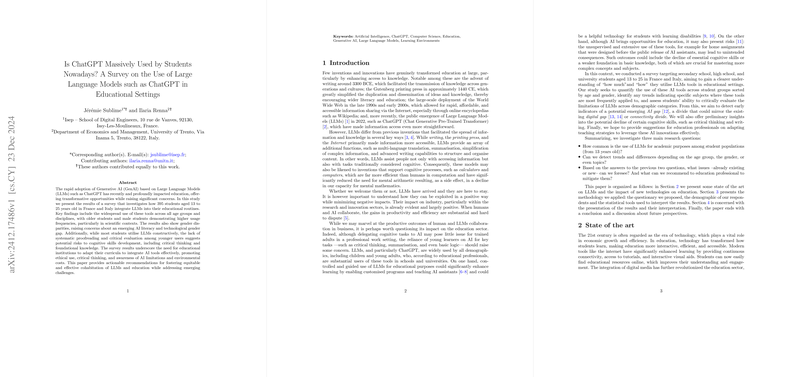Integration of LLMs into Educational Settings: A Comprehensive Study
The paper "Is ChatGPT Massively Used by Students Nowadays? A Survey on the Use of LLMs such as ChatGPT in Educational Settings" offers an extensive exploration of how students incorporate LLMs, specifically ChatGPT, into their educational routines. The paper's significance lies in its detailed survey conducted across diverse age groups from 13 to 25 years in France and Italy, providing insights into the prevalent use of LLMs in education and their implications.
Key Findings
The survey involved 395 students, and the findings underscore the widespread adoption of LLMs in educational settings. Notably, students across all age groups and academic disciplines utilize these tools frequently. Older students and male participants reported higher usage, particularly in scientific contexts, suggesting some patterns in user demographics and the areas of academic focus. The paper highlights gender disparities in LLM use, emphasizing the need for educational equity and addressing the gender gap in AI literacy.
A significant finding is the high satisfaction level among students with LLM-generated responses, although younger students often fail to systematically proofread or critically evaluate these outputs. This complacency may pose risks to skill development in critical thinking and foundational knowledge. These patterns suggest an evolving educational landscape where traditional assessments and pedagogical approaches must adapt to the presence of AI technologies.
Implications and Recommendations
The research underscores the urgent need for educational institutions to integrate AI tools effectively into curricula. By doing so, they can promote ethical use, encourage critical thinking, and raise awareness of AI's limitations and environmental costs. The integration should focus on fostering students' cognitive skills despite the reliance on AI for summary and content generation tasks.
Addressing gender disparities requires targeted interventions to ensure equal access and familiarity with AI technologies among male and female students. Such measures are crucial to mitigate the risk of widening the AI literacy gap, which could exacerbate existing inequalities in technological fields and beyond.
Future Directions
Forward-thinking educational strategies should include the systematic incorporation of LLMs into teaching methodologies, emphasizing critical evaluation of AI-generated content. As these technologies are here to stay, their impact on cognitive skills development, educational outcomes, and professional preparedness must be a priority in educational research and policy making.
Moreover, future research could explore understanding the nuances of gender differences in AI tool adoption, exploring factors beyond educational settings that influence these trends. Additionally, longitudinal studies might provide valuable insights into the long-term implications of AI tool usage in formative educational stages.
In conclusion, this paper highlights the transformative impact of LLMs on education and underscores the urgent need for adaptive and inclusive educational frameworks. By integrating these tools thoughtfully, educational systems can harness their potential to enhance learning while safeguarding and nurturing essential cognitive skills.
